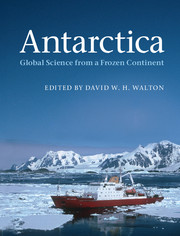Book contents
- Frontmatter
- Contents
- List of contributors
- Introduction
- 1 Discovering the unknown continent
- 2 A keystone in a changing world
- 3 Ice with everything
- 4 Climate of extremes
- 5 Stormy and icy seas
- 6 Life in a cold environment
- 7 Space science research from Antarctica
- 8 Living and working in the cold
- 9 Scientists together in the cold
- 10 Managing the frozen commons
- 11 Antarctica: a global change perspective
- Appendix A Visiting Antarctica
- Appendix B Further reading
- Acknowledgements
- Index
4 - Climate of extremes
Published online by Cambridge University Press: 05 March 2013
- Frontmatter
- Contents
- List of contributors
- Introduction
- 1 Discovering the unknown continent
- 2 A keystone in a changing world
- 3 Ice with everything
- 4 Climate of extremes
- 5 Stormy and icy seas
- 6 Life in a cold environment
- 7 Space science research from Antarctica
- 8 Living and working in the cold
- 9 Scientists together in the cold
- 10 Managing the frozen commons
- 11 Antarctica: a global change perspective
- Appendix A Visiting Antarctica
- Appendix B Further reading
- Acknowledgements
- Index
Summary
We had discovered an accursed country. We had found the home of the blizzard.
Sir Douglas Mawson, Australasian Antarctic Expedition, 1911–14Antarctica is the coldest, windiest and driest continent on Earth. Temperatures at the surface of the continent have fallen to –89ºC, the coldest surface temperature ever observed on Earth, and monthly mean wind speeds have been recorded in excess of hurricane strength. Antarctica can be considered a desert, yet 99% of the continent is covered in ice. What is it about the Antarctic continent that causes such extreme weather and how does Antarctic weather affect the rest of the planet?
Scientists have been fascinated by Antarctica's weather since the earliest explorers returned with unbelievable descriptions of storms, cold and wind. We now know much more about the processes that create this unique, harsh and dramatic climate and how this distant polar climate impacts those of us who live in more hospitable locations. While it may be difficult to see how Antarctica, a continent at the bottom of our planet and far distant from where most of us live, can impact our lives, Antarctica plays a central role in shaping and driving our global climate and the changes that occur there can have far reaching impacts on the rest of the planet.
- Type
- Chapter
- Information
- AntarcticaGlobal Science from a Frozen Continent, pp. 102 - 136Publisher: Cambridge University PressPrint publication year: 2013
- 7
- Cited by



